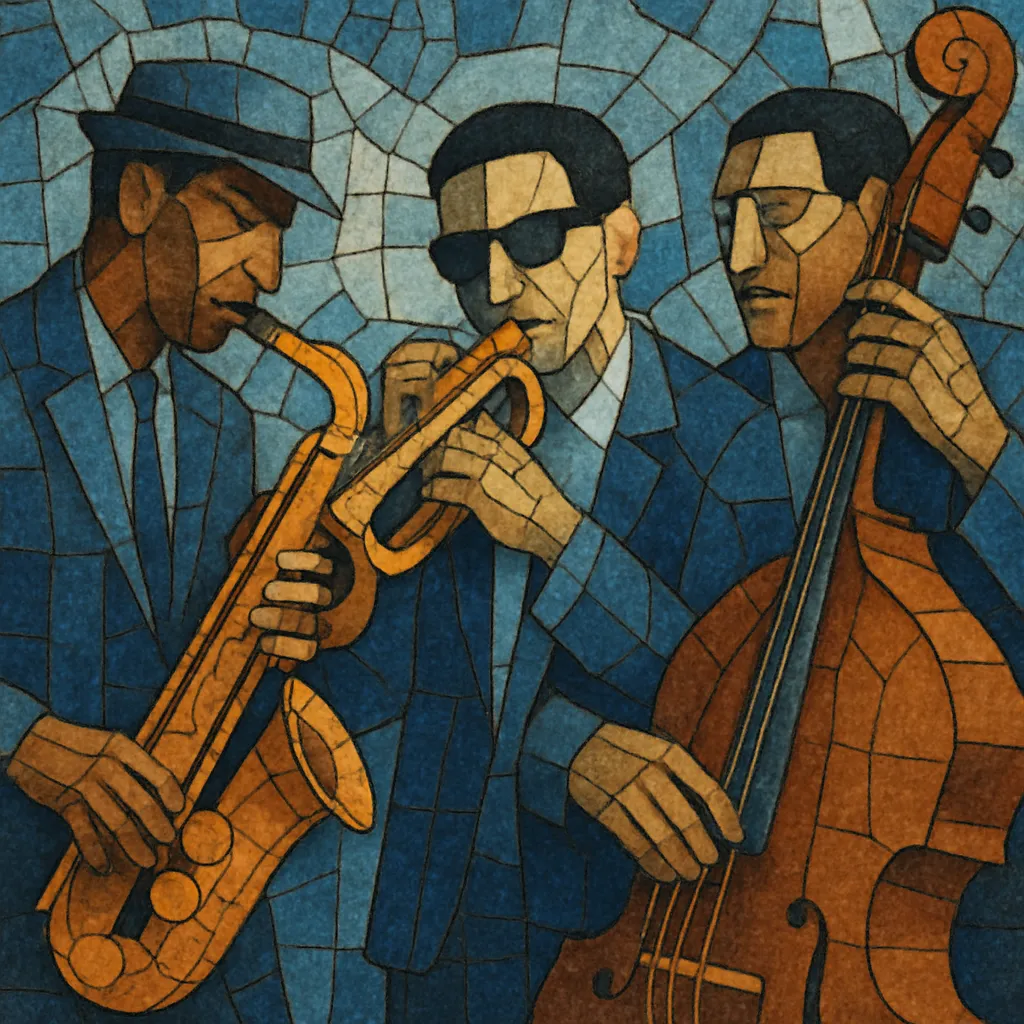Cool jazz is a modern jazz style marked by relaxed tempos, lighter tone, and a focus on arrangement, counterpoint, and timbral clarity. It favors understatement over virtuoso display and uses dynamics, space, and balance to create an airy, "cool" ambience.
Emerging in the late 1940s, the style drew on bebop’s harmonic sophistication while smoothing its angular edges, often incorporating classical techniques such as linear writing and orchestral color. Hallmarks include brushed drums, lyrical improvisation, careful voice-leading, and unusual instrumentation (for jazz) like French horn and tuba alongside trumpet, saxophones, trombone, piano, bass, and drums.
Although associated with the U.S. West Coast in the 1950s, cool jazz originated in New York through sessions led by Miles Davis and arranged by Gil Evans and others. It went on to influence bossa nova, third stream, modal jazz, and later smooth jazz and lounge aesthetics.
Cool jazz coalesced in New York City around Miles Davis’s nonet recordings later compiled as "Birth of the Cool" (1949–1950). Arrangers Gil Evans, Gerry Mulligan, and John Lewis shaped a chamber-like sound that contrasted bebop’s aggressive drive. Concurrently, the Lennie Tristano school (with Lee Konitz and Warne Marsh) explored linear counterpoint, relaxed articulation, and intellectual harmonic approaches that fed into the idiom.
During the 1950s the style flourished, especially on the U.S. West Coast. Gerry Mulligan and Chet Baker’s pianoless quartet showcased spare textures, while the Dave Brubeck Quartet (with Paul Desmond) popularized refined melodies and sophisticated forms. Stan Getz’s warm, breathy tone became emblematic of the cool aesthetic. Though “West Coast jazz” was a regional tag, the musical values—balance, clarity, and restraint—were broader than geography.
Hard bop emerged partly as a reaction to cool jazz, re-centering blues, gospel, and a more driving rhythmic feel. Simultaneously, cool jazz’s orchestral leaning, counterpoint, and notated passages helped pave the way for third stream (Gunther Schuller’s term for fusing jazz and classical procedures). Its emphasis on modal color and lyricism informed later modal jazz developments (not least via Miles Davis), and its smooth sonics echoed through lounge, space-age pop, and, decades later, smooth jazz.
By the early 1960s, cool jazz directly shaped the global success of bossa nova collaborations (e.g., Stan Getz with João Gilberto), where airy tone and understated swing met Brazilian rhythm and harmony. The cool palette—measured dynamics, clean lines, and careful arranging—remains a reference point for jazz education, studio production aesthetics, and crossover projects that seek intimacy and clarity over sheer intensity.
Favor ensembles that allow textural transparency: trumpet, alto/tenor/baritone saxophones, trombone, and a rhythm section (piano, double bass, drums with brushes). For orchestral color, add French horn and tuba (as in the classic nonet). Aim for blended timbres and balanced voicings across the ensemble.
Use relaxed to medium tempos with a supple, lightly swinging ride cymbal and prominent hi-hat on beats 2 and 4. Prefer brushes to sticks for a soft attack. Keep bass walking lines even and supportive; avoid overly syncopated comping that clutters the texture.
Write harmonies with extended tertian colors (9ths, 11ths, 13ths) and prioritize smooth, stepwise inner voices. Employ non-functional progressions, modal vamps, and substitute dominants to soften cadences. Use counterpoint and linear writing so parts interlock melodically rather than stack as block chords.
Craft lyrical, singable themes with clear motifs and contour. In solos, favor thematic development, space, and dynamic nuance over dense flurries. Outline guide tones, use upper-structure triads and chord-scale relationships, and lean into tone control (subtone, breathy attacks) to project a cool, airy character.
Balance written passages with improvisation. Use soft dynamics, call-and-response between sections, and re-voiced head statements. Consider unusual orchestrations (e.g., muted trumpet against low woodwinds or horn/tuba pads) for color. Keep endings understated—fade-outs, soft tags, or quietly reharmonized codas.
Record with close yet natural mic placement to capture warmth and detail. Leave headroom and avoid excessive compression. On stage, maintain blend and balance; let lines breathe. The aesthetic is clarity, restraint, and poise—say more with less.


